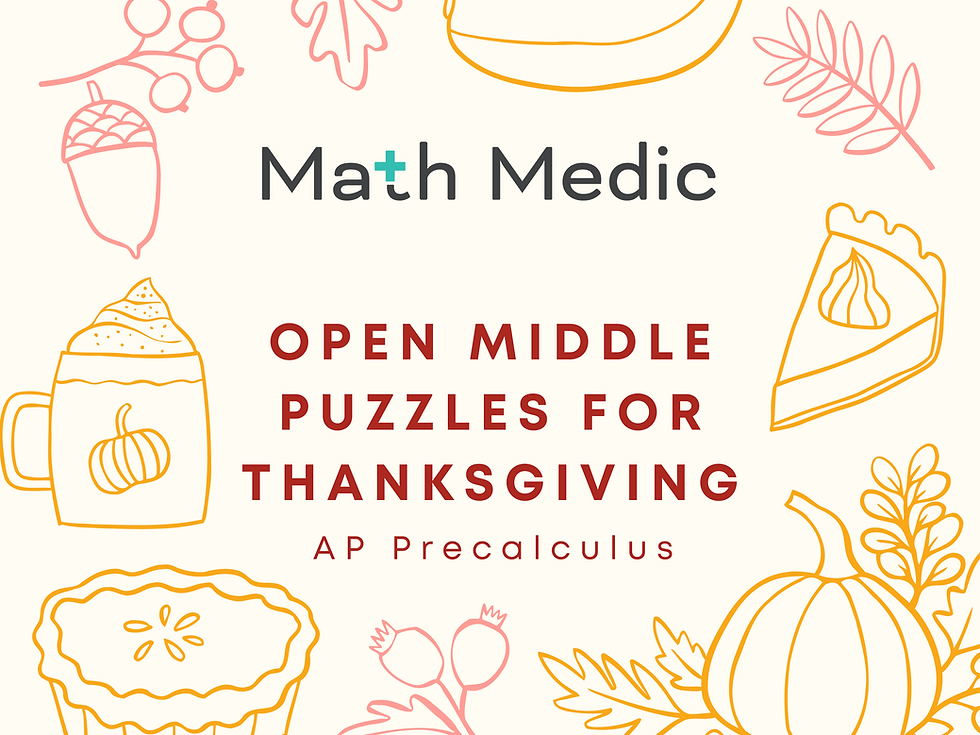Regression Round Table
- Sarah Stecher

- Mar 22, 2024
- 3 min read
Updated: Apr 29
One of the key differences between AP Precalculus and a traditional Precalculus course is its focus on modeling. Students will be asked to write equations that represent contextual, scenarios, certain function characteristics, or data sets. The three types of modeling students will be asked to do are:
Deterministic: the question gives all the information needed and there is one correct answer. (Ex: Write an equation that models the number of bacteria for a population that initially has 7 bacteria and triples every week. Or, write an equation for a function that has shifted three units to the left from the parent function.)
Matching Criteria: the question asks students to generate a function that satisfies certain criteria and there are multiple right answers (Ex: Write a function that has a horizontal asymptote at y=2)
Bivariate Data Sets: the question asks students to find and analyze a regression model for a given data set, often using it to find a predicted output value.
Regression Round Table is all about that third type of modeling, where students must be able to flexibly use the statistical tools of their calculator to calculate a regression equation AND make sense of the model and its limitations. (To help students practice the first and second types of modeling, check out the Chili Pepper Function Challenge.)
How to Play:
Students will work in groups of 4. Each group member starts with one of the four problem sets and completes part a (identifying independent and dependent variables, analyzing the function type, and entering the data into their calculator). After an allotted time, they must rotate papers so they are working on a different problem set. After checking the work of their peer in part a, the student completes part b (calculating the regression model). They then pass papers again, check the work that was done so far on the problem set and continue to part c (making a prediction using the regression model). In part d, the fourth person will calculate and interpret a residual, being sure to mention if the model gives an overestimate or underestimate for that particular input value.
Allow for slightly more time on each part since students must check the work of everyone before them. Have students affirm or high-five each other as they pass papers to build class community. At the end, have students look at their original paper to review the solution. Give students 3-5 minutes to ask each other any questions they had while solving.
Suggested times:
Part a: 4 minutes
Part b: 5 minutes
Part c: 6 minutes
Part d: 4 minutes
Review solution on original problem set: 4 minutes
Each of the four problem sets features real-world data that can be modeled by different function types (cubic, logarithmic, exponential, and sinusoidal).
Downloads
Activity:
Answer Key:
How does regression show up on the AP Precalc Exam?
Since the four FRQs are all based on neatly defined task models, we know for certain that students will NOT be doing regression on the free response questions. However, regression is likely to appear in the multiple choice section. Based on all the practice exams, here are the kinds of questions students could expect to see:
Using a regression model to predict an output value
Calculating a residual and interpreting its value
Determining if the regression model gives an overestimate or underestimate of the true value
Analyzing a residual plot for a given regression model to see if the model is a good fit
Notes:
It is unlikely that students will be asked to produce the regression equation as the whole extent of the problem. They are more likely to have to calculate it and then use it in some way.
Students will likely not be given data sets as large as in the Regression Round Table activity. The College Board will likely present a more "cleaned up" data set with only 4-6 key values.



